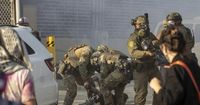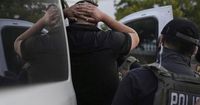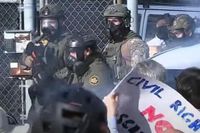On the brisk morning of September 19, 2025, the quiet suburb of Broadview, Illinois, erupted in protest. Demonstrators gathered outside the U.S. Immigration and Customs Enforcement (ICE) processing facility, their voices echoing a growing unease across Chicago’s immigrant communities. It was a scene that would play out for hours, stretching from sunrise to deep into the night, as federal agents launched pepper balls and tear gas in an effort to disperse the crowd. By the end of the day, ten protesters had been arrested—though, according to the National Lawyers Guild, all were later released. The question on many minds: what exactly is happening in Chicago, and why has it become the latest flashpoint in the national immigration debate?
The answer lies in Operation Midway Blitz, a sweeping enforcement effort launched by ICE on September 8, 2025. According to the Department of Homeland Security, nearly 550 people had been arrested in the Chicago area as of September 19, with figures climbing steadily as the operation continued. The scale of the effort was immediately apparent, not only in the number of arrests but in the heavy law enforcement presence that quickly became a fixture in neighborhoods across the city. As reported by the Associated Press, the operation brought with it a visible uptick in federal agents—and, inevitably, a surge of anxiety in communities already wary of aggressive tactics and mass detentions.
Operation Midway Blitz is part of a broader push by the Trump administration to crack down on undocumented immigrants, a campaign that has previously targeted cities like Los Angeles and Washington, D.C. The administration’s approach has been controversial, drawing fierce criticism from local officials and activists who argue that such enforcement measures are dangerous and imprecise. In Chicago, these concerns were amplified by reports that U.S. citizens had been mistakenly detained by federal officers during the sweep. According to Marcos Charles, acting head of ICE’s Enforcement and Removal Operations, roughly half of the arrests were “targeted”—that is, aimed at specific individuals with criminal convictions, final orders of removal, or other reasons to be on ICE’s radar. The rest were “collateral arrests,” meaning people encountered during raids who were found to be in the country illegally. As Charles put it, “It doesn’t mean that the collateral arrests are non-criminal. Some of our collateral arrests … also have criminal convictions and arrests. They just weren’t the people we were looking for at the time.”
Collateral arrests, which had been restricted during the Biden administration, were reinstated almost immediately after President Trump took office, part of a wider effort to expand deportations. The Department of Homeland Security has justified the operation by pointing to state and local policies in Chicago and Illinois that limit cooperation with ICE. According to ICE, these so-called "sanctuary" policies mean that immigrants who might be deportable are instead released into the community, forcing federal agents to track them down later—often with dramatic and disruptive results.
Not everyone agrees with this assessment. Many local officials and advocacy groups maintain that immigration enforcement is a federal responsibility, and that if local police work too closely with ICE, it undermines public safety by making immigrants less likely to report crimes or cooperate with law enforcement. As Illinois Lt. Gov. Juliana Stratton observed at the Broadview protest, “They want us to be afraid. They want us to just kind of go into our little corners and not do anything. … We’re not going to let that happen.”
The protests themselves were a study in contrasts. On Friday, demonstrators at the Broadview facility clashed with federal agents, who used chemical agents to break up the crowd. Some protesters described the scene as peaceful, with participants holding signs and singing songs; others, including ICE officials, accused demonstrators of assaulting law enforcement, slashing car tires, and blocking facility entrances. Kat Abughazaleh, a congressional candidate who joined the protest, recounted being thrown to the ground and hit with tear gas. “Protesters were completely peaceful,” she insisted. “We had no weapons, just signs and songs. We were afraid and angry.” ICE, for its part, labeled the protesters “rioters” and claimed that local police refused to respond to multiple calls for assistance from federal agents.
Brad Thomson, a spokesperson for the National Lawyers Guild, said, “Our legal observers witnessed federal agents using indiscriminate violence against demonstrators. Numerous people suffered physical injuries, including people who required treatment at the hospital.” The National Lawyers Guild had deployed legal observers to the scene, offering support to anyone in need of representation. Despite the chaos, the protest continued for hours, finally dispersing around 10 p.m. as rain began to fall.
But the spirit of resistance didn’t end there. The following day, a smaller group of about 40 people returned to the Broadview facility, braving the drizzle to show continued support for immigrants. The scene was quieter, with fewer officers visible, but tensions remained high. One woman, who asked to remain anonymous for her safety, described helping to secure the release of a detainee by providing ICE with documentation proving his U.S. citizenship. “Eventually, she caught the attention of one officer who took the paperwork and gave the woman a number to call within a few hours,” reported the Chicago Sun-Times. Several hours later, the man was released, a rare moment of relief in an otherwise fraught situation.
Meanwhile, nearly 200 protesters gathered near the Naval Station Great Lakes, north of Chicago, which had become a staging area for federal agents. Demonstrators held signs reading “Welcome the stranger” and “ICE out,” demanding that ICE and federal military forces leave Illinois. The Rev. David Black, a Presbyterian minister who had been pepper-sprayed at the Broadview protest the day before, led the crowd in chants of “Shame on ICE” and “No more deportations.” According to organizers, calls to the Illinois Coalition for Immigrant and Refugee Rights hotline remained high as the enforcement surge continued to rattle the community.
While the Trump administration has promised to send more immigration agents—and even National Guard troops—to Chicago, a full military deployment had not materialized as of September 19. Still, the heavy presence of federal agents and the scale of Operation Midway Blitz have left an indelible mark on the city. Supporters of the administration argue that the crackdown is necessary to enforce the law and protect public safety, while critics warn that it risks tearing families apart and undermining trust in law enforcement.
As the debate rages on, the events in Chicago serve as a microcosm of the national struggle over immigration policy. The faces in the crowd—protesters, federal agents, local officials, and ordinary residents—are each caught in the crosscurrents of a conflict that shows no sign of resolution. For those on the front lines, whether marching in the rain or waiting anxiously for word of a loved one’s release, the stakes could not feel more immediate or more personal.


